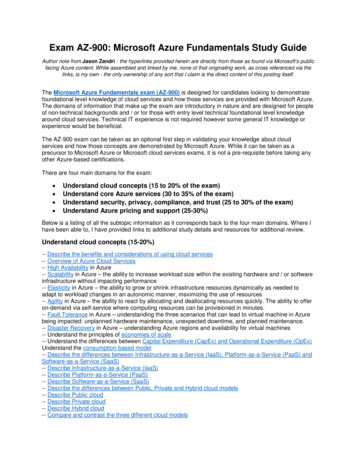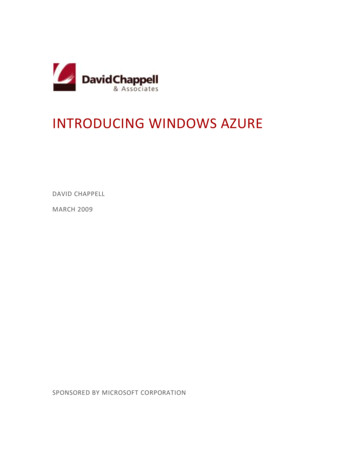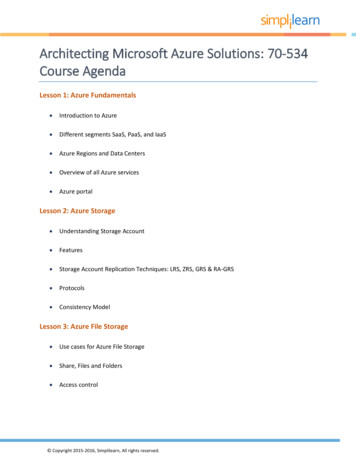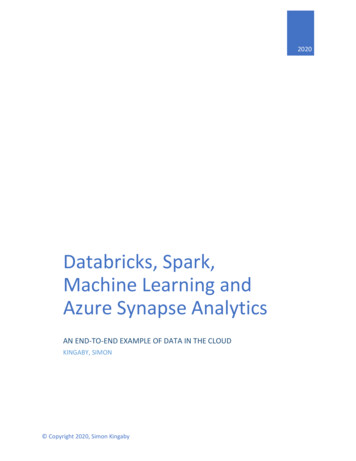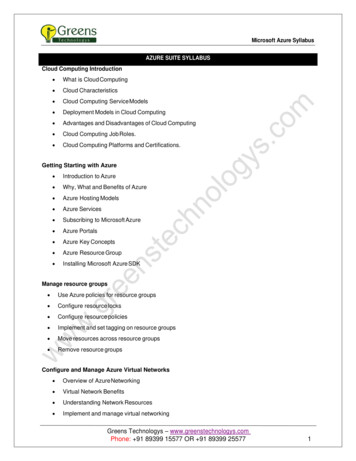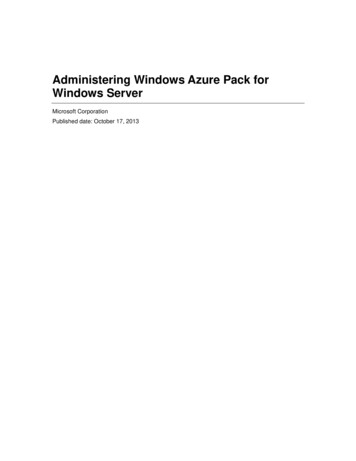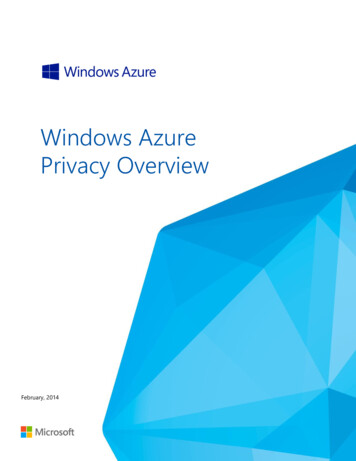
Transcription
Windows AzurePrivacy OverviewFebruary, 2014
Windows Azure Privacy OverviewTable of ContentsINTRODUCTION . 3MICROSOFT APPROACH TO PRIVACY IN THE CLOUD . 3YOUR DATA IN WINDOWS AZURE . 3LOCATION OF CUSTOMER DATA . 4DATA ACCESS AND USE . 4CONTRACTUAL COMMITMENTS . 5E.U. Data Protection Directive . 5HIPAA Business Associate Agreement (BAA) . 5SUBCONTRACTORS . 6LAW ENFORCEMENT REQUESTS . 6BUILT IN DATA PROTECTION . 7Identity and Access . 7Data Encryption, Isolation, and Destruction . 7Network Security . 8CONCLUSION AND ADDITIONAL RESOURCES . 8Additional Resources. 9P A G E 02
Windows Azure Privacy OverviewIntroductionMicrosoft recognizes that cloud services are raising unique privacy challenges for organizations.To enable organizations to realize the benefits of the cloud, Microsoft implements strongprivacy protections in Windows Azure services and makes commitments to safeguard theprivacy of customer data. In addition, Microsoft strives to be transparent so customers havevisibility into where their data resides and who has access to it.In the following pages, we will discuss Microsoft's approach to privacy in the cloud as well as thespecific policies, operational practices, and technologies that are in place to help ensure theprivacy of your data in Windows Azure.Microsoft Approach to Privacy in the CloudMicrosoft has been a leader in creating robust online solutions that protect the privacy of ourcustomers for twenty years. Today, we operate more than 200 cloud and online services thatserve hundreds of millions of customers across the globe. Our enterprise cloud services, such asOffice 365 and Windows Azure, serve millions of end users whose companies entrust theirmission-critical data to Microsoft.Our experience has enabled us to develop industry-leading business practices, privacy policies,compliance programs, and security measures that we apply across our cloud computingecosystem. Driven by a commitment to empower organizations to control the collection, use,and distribution of their data, our time-tested approach to privacy provides a solid foundationfor addressing customer privacy requirements and enabling greater trust in cloud computing.Your Data in Windows AzureWith Windows Azure, customers own their data. We define Customer Data as “all the data,including all text, sound, software or image files that a customer provides, or are provided onthe customers’ behalf, to Microsoft through use of the Services.” For example, this includes datathat you upload for storage or processing and applications that you run in Windows Azure.Refer to the Windows Azure Trust Center for a detailed understanding of how Microsoftclassified data in Windows Azure.Customers can retrieve their Customer Data at any at any time and for any reason, typicallywithout assistance from Microsoft. When a customer chooses to delete data or leave the service,Microsoft removes the Customer Data from all systems under its control. Upon systems end-oflife, Microsoft operational personnel follow rigorous data-handling procedures and hardwaredisposal processes.P A G E 03
Windows Azure Privacy OverviewLocation of Customer DataFor many customers, knowing and controlling the location of their data can be an importantelement of compliance and governance. With Windows Azure, customers can specify thegeographic area(s), which we call "geos" and "regions", of the Microsoft datacenters in whichtheir Customer Data will be stored. Available geos and regions are shown in the following table.GeoRegionAsia PacificAsia Pacific East (Hong Kong)Asia Pacific Southeast (Singapore)EuropeEurope North (Ireland)Europe West (Netherlands)United StatesUS North Central (Illinois)US South Central (Texas)US East (Virginia)US West (California)JapanJapan East (Saitama Prefecture)Japan West (Osaka Prefecture)See the Windows Azure Trust Center for the most up-to-date list of geos and regions and theWindows Azure Regions page for information on our global network of datacenters.Microsoft may transfer Customer Data within a geo (such as, from Europe North to EuropeWest) for data redundancy or other purposes. For example, Windows Azure replicates Blob andTable data between two regions within the same geo for enhanced data durability in case of amajor datacenter disaster.Microsoft will not transfer Customer Data outside the geo(s) a customer specifies (for example,from Europe to U.S. or from U.S. to Asia) except where necessary for Microsoft to providecustomer support, troubleshoot the service, or comply with legal requirements; or where thecustomer configures the account to enable such transfer of Customer Data through the use ofspecific features and services as outlined in the Windows Azure Trust Center.Microsoft does not control or limit the geos from which customers or their end users may accessCustomer Data.Data Access and UseAccess to your data by Microsoft personnel is restricted. Customer Data is only accessed whennecessary to support your use of Windows Azure. This may include troubleshooting aimed atpreventing, detecting or repairing problems affecting the operation of Windows Azure and theimprovement of features that involve the detection of, and protection against, emerging andevolving threats to the user (such as malware or spam). When granted, access is carefullyP A G E 04
Windows Azure Privacy Overviewcontrolled and logged. Strong authentication, including the use of multi-factor authentication,helps limit access to authorized personnel only. Access is revoked as soon as it is no longerneeded.Windows Azure does not share Customer Data with its advertiser-supported services. We alsodo not mine Customer Data for advertising.The operational processes and controls which govern access and use of Customer Data inWindows Azure are rigorously maintained and regularly verified by accredited audit firms.Contractual CommitmentsMicrosoft makes strong contractual commitments to safeguard Customer Data and provideprivacy protections. This includes provisions for customers in geographies or industries withadditional controls around personal data.E.U. Data Protection DirectiveEuropean law prohibits companies from transferring personal data from the EU except underspecific conditions. One way to transfer such data is to procure cloud services from companiesthat abide by the U.S.-EU Safe Harbor and Swiss-U.S. Safe Harbor frameworks.To accommodate the data privacy demands of European entities, Microsoft is Safe Harborcertified under the U.S. Department of Commerce. The Safe Harbor certification allows for thelegal transfer of E.U. personal data outside of the E.U. to Microsoft for processing. This addressesthe limited instances when data is transferred outside of the customer-specified geographicregion. Microsoft also offers additional contractual commitments to its enterprise customers: A Data Processing Agreement that details our compliance with the E.U. Data ProtectionDirective and related security requirements for Windows Azure core features withinISO/IEC 27001:2005 scope E.U. Model Contractual Clauses that provide additional contractual guarantees aroundtransfers of personal data for Windows Azure core features within ISO/IEC 27001:2005scopeHIPAA Business Associate Agreement (BAA)Windows Azure also complies with the Health Insurance Portability and Accountability Act(HIPAA) and the Health Information Technology for Economic and Clinical Health (HITECH) Act.These are United States laws that apply to healthcare entities with access to patient information(called Protected Health Information, or PHI). In many circumstances, for a covered healthcarecompany to use a cloud service like Windows Azure, the service provider must sign a writtenagreement to adhere to certain security and privacy provisions set forth in HIPAA and theP A G E 05
Windows Azure Privacy OverviewHITECH Act. To help customers comply with HIPAA and the HITECH Act, Microsoft offers aBusiness Associate Agreement (BAA) to enterprise customers as a contract addendum.Prior to signing the BAA, customers should read the Windows Azure HIPAA ImplementationGuidance to understand the relevant capabilities of Windows Azure. The document covers someof the best practices for building HIPAA compliant applications, and details Windows Azureprovisions for handling security breaches.SubcontractorsMicrosoft may hire other companies to provide limited services on its behalf, such as providingcustomer support. Microsoft will only disclose Customer Data to subcontractors so that they candeliver the services we have retained them to provide. Subcontractors are prohibited from usingCustomer Data for any other purpose, and they are required to maintain the confidentiality ofour customers’ information.We require subcontractors to join Microsoft's Supplier Security & Privacy Assurance Program, tomeet our privacy requirements by contract, and to undergo regular privacy training. Wecontractually obligate subcontractors that work in facilities or on equipment controlled byMicrosoft to follow our privacy standards. All other subcontractors are contractually obligated tofollow privacy standards equivalent to our own. Download the list of subcontractors to seewhich companies are authorized to process Customer Data in Windows Azure.Law Enforcement RequestsMicrosoft believes that our customers should control their own data whether stored on theirpremises or in a cloud service. Accordingly, we will not disclose Customer Data to a third party(including law enforcement, other government entities or civil litigants) except as our customersdirect us or as required by law. Should a third party contact us with a demand for CustomerData, we will attempt to redirect the third party to request it directly from our customers. As partof that, we may provide customers’ basic contact information to the third party. We require acourt order or warrant before we will consider disclosing content to law enforcement. Ifcompelled to disclose Customer Data to a third party, we will promptly notify the customer andprovide a copy of the demand to them, unless legally prohibited from doing so.Microsoft also publishes a Law Enforcement Requests Report that provides insight into thescope and number of requests. To learn more about how Microsoft responds to requests forCustomer Data, read the Responding to government legal demands for Customer Data blogpost from Microsoft’s General Counsel.P A G E 06
Windows Azure Privacy OverviewBuilt In Data ProtectionMicrosoft designed and implemented the Windows Azure platform to enable our customers toprotect their data and its privacy. Windows Azure provides the infrastructure our customers canuse to: help Control access to their data and applications Protect data in transit and at rest Securely connect to Windows AzureIdentity and AccessMicrosoft offers comprehensive identity and access management solutions for customers to useacross Windows Azure and other Microsoft cloud services. Specifically, Windows Azure includesthe following features to enable customers to control access to their data and applications: Enterprise cloud directory. Organizations can sync on-premises identities to WindowsAzure Active Directory and enable single sign-on to simplify user access to their cloudapplications. Access Monitoring. Security reports monitor inconsistent access patterns and help tomitigate potential threats. Strong authentication. Windows Azure Multi-Factor Authentication helps preventunauthorized access by providing an authentication mechanism in addition to apassword. Role-based access control. Our customers can implement authorization schemes thatcontrols users’ access to resources based on their role assignment, their roleauthorization, and their permission authorization.Data Encryption and IsolationWindows Azure safeguards Customer Data using three specific methods: encryption,segregation, and destruction. Data in transit. For data in transit, Windows Azure uses industry standard transportprotocols such as SSL and TLS between user devices and Microsoft datacenters, andwithin datacenters themselves. IPsec can also be used to create a VPN connection with aWindows Azure Virtual Network (VNET). Customers can enable encryption for trafficbetween their own Virtual Machines and end users. Data at rest. Customers are responsible for ensuring that data stored in Windows Azureis encrypted in accordance with their standards. Windows offers a wide range ofencryption capabilities, giving customers the flexibility to choose the solution that bestmeets their needs. Options include.NET cryptographic services, Windows Server publickey infrastructure (PKI) components, Microsoft StorSimple cloud-integrated storage,P A G E 07
Windows Azure Privacy OverviewActive Directory Rights Management Services (AD RMS), and BitLocker for dataimport/export scenarios. Data isolation. Windows Azure is a multi-tenant service, meaning that multiplecustomers’ deployments and virtual machines are stored on the same physical hardware.Windows Azure Storage uses logical isolation to segregate each customer’s data fromthat of others. This provides the scale and economic benefits of multitenant serviceswhile rigorously preventing customers from accessing one another’s data. Data destruction. When customers delete data or leave Windows Azure, Microsoftfollows strict rigorous standards that call for overwriting storage resources before reuse,as well as physically disposing of decommissioned hardware.Network SecurityWindows Azure networking provides the infrastructure necessary to securely connect VMs toone another as well as to make connections between on-premises datacenters and WindowsAzure VMs. Windows Azure blocks unauthorized traffic to and within Microsoft datacentersusing a variety of technologies such as firewalls, NATs, partitioned Local Area Networks andphysical separation of back-end servers from public-facing interfaces. Isolating Customer Data and networks. Fundamental to any shared cloud architectureis the isolation provided for each customer. In Windows Azure, a customer subscriptioncan include multiple deployments, and each deployment can contain multiple VMs.Windows Azure isolates deployments and virtual networks from one another. IndividualVMs do not receive inbound Internet traffic except through customer-defined endpoints. Encrypting communications. Built-in cryptographic technology enables customers toencrypt communications within and between deployments, between Windows Azureregions, and from Windows Azure to on-premises datacenters. All of these protocols aredesigned to provide a high default level of network security while giving customers theflexibility and choice to configure Windows Azure to meet business needs. Administratoraccess to virtual machines through remote desktop sessions, remote WindowsPowerShell, and the Windows Azure Management Portal is always encrypted. Using Express Route. Customers can use an optional Express Route private fiber linkinto Windows Azure datacenters to keep their traffic off the Internet.Conclusion and Additional ResourcesMicrosoft has a longstanding commitment to privacy, which is an integral part of how we build,deploy, and manage Windows Azure. We work to be transparent in our privacy practices, tooffer customers meaningful privacy choices, and to manage responsibly the data we store.P A G E 08
Windows Azure Privacy OverviewWe publish detailed information about Windows Azure privacy, security, and compliance in ourTrust Center and provide access to audit reports and compliance packages to assist customers inunderstanding the policies, operational processes, and technologies in place to help safeguardthe privacy of their data.Additionally, customers can read more general information about Microsoft’s work to protectCustomer Data across all of our cloud services on the Microsoft Cloud Privacy Web Site and inthe Privacy in the Cloud white paper.Additional Resources Windows Azure Privacy Statement Microsoft Trustworthy Computing Privacy Web Site Law Enforcement Request Report Data Classification for Cloud Readiness CISO Perspectives on Data ClassificationP A G E 09
Windows Azure are rigorously maintained and regularly verified by ac credited audit firms. Contractual Commitments Microsoft makes strong contractual commitments to safeguard Customer Data and provide privacy protections. This includes provisions for customers in geographies or industries with . Download the list of subcontractors to see
